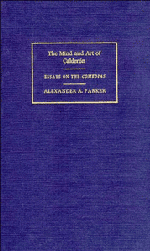Book contents
- Frontmatter
- Contents
- Author's preface
- Editor's preface
- Introduction
- I Stylistic and dramatic craftsmanship
- II From experience to myth
- 6 The father–son conflict
- 7 Segismundo's tower: a Calderonian myth
- 8 Horoscopes and their fulfilment
- 9 Fate and human responsibility (1): the problem
- 10 Fate and human responsibility (2): a dramatic presentation – El mayor monstruo los celos
- III The tensions of social life
- IV The tensions of public life
- V From symbol to myth
- Epilogue
- Notes
- Index
8 - Horoscopes and their fulfilment
Published online by Cambridge University Press: 05 February 2012
- Frontmatter
- Contents
- Author's preface
- Editor's preface
- Introduction
- I Stylistic and dramatic craftsmanship
- II From experience to myth
- 6 The father–son conflict
- 7 Segismundo's tower: a Calderonian myth
- 8 Horoscopes and their fulfilment
- 9 Fate and human responsibility (1): the problem
- 10 Fate and human responsibility (2): a dramatic presentation – El mayor monstruo los celos
- III The tensions of social life
- IV The tensions of public life
- V From symbol to myth
- Epilogue
- Notes
- Index
Summary
La vida es sueño has been shown to be a seminal work. Horoscopes had been introduced into earlier plays, but apart from the doubtfully authentic Las cadenas del demonio (The Devil's Fetters), they had not been associated with imprisonment from birth. This association gives form and content to the ‘myth’ of the prison and starts it on its long career. La vida es sueño is also seminal in that it gives a clear analysis, in dramatic terms, of actions that aim to control events and make them conform to one's own plans (‘dreaming’) and those that follow from an acceptance of events as they are, aiming at following a course of action in accord with events as they unfold and not against them (‘being awake’). Making decisions and planning courses of action in accord with events without seeking to control or counter them is at the heart of the dramatic function of horoscopes and prophecies as Calderón presents them, and is therefore bound up with the problem of Fate.
The basic quotations adduced as evidence of Calderón's concept of Fate and Destiny come, naturally enough, from La vida es sueño. On the one hand there is the clear assertion that it is impossible to escape one's fate; on the other hand it is also asserted that prudence can overcome Fate. Before he dies, Clarín says:
que no hay seguro camino
a la fuerza del destino
y a la inclemencia del hado.
- Type
- Chapter
- Information
- The Mind and Art of CalderónEssays on the Comedias, pp. 96 - 106Publisher: Cambridge University PressPrint publication year: 1989

